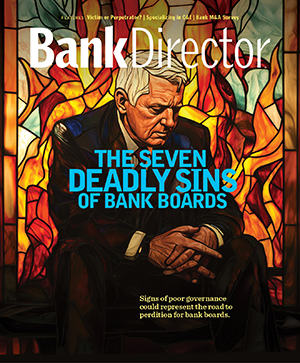
The Bank Director Nifty Fifty
 In an industry that is more heavily capitalized than it has been in decades, banks and thrifts are arguably safer than they have been in decades. On the other hand, they’re not very profitable. As leverage goes down, so do banking profits. In times like these, investors want to know which banks will make the best use of their capital.
In an industry that is more heavily capitalized than it has been in decades, banks and thrifts are arguably safer than they have been in decades. On the other hand, they’re not very profitable. As leverage goes down, so do banking profits. In times like these, investors want to know which banks will make the best use of their capital.
For the second year in a row, Bank Director magazine and Sandler O’Neill + Partners have ranked the top 50 best users of capital based on profitability and capital strength, both weighted equally. The metrics that determine the winners are core return on tangible common equity and the ratio of tangible common equity to tangible assets. The data is for eight consecutive quarters through June of 2012.
The reasoning behind the ranking is that when comparing two banks that are both equally profitable, the one that is more heavily capitalized is doing a better job for investors than the one that is not. In an age where banks are forced to carry more capital, the ability to deliver industry leading returns without the advantage of high leverage provides affirmation of a bank’s strategy and the execution skills of its management team.
There is a consistency of story in most of the top ranked banks. For one, they tend to be very well run community banks with low cost deposits, good asset quality, high levels of fee income or a strong niche lending business.
Twelve of the top 15 banks in last year’s list again made it to the top 15 this year, including Republic Bancorp in Louisville, Kentucky, and First Financial Bankshares in Abilene, Texas.
“A lot is driven on the deposit side with a higher level of non-interest bearing deposits, which you generally find at commercially focused banks rather than thrifts,” says Alexander Twerdahl, associate director of equity research at Sandler O’Neill + Partners in New York.
The banks who topped the list tend also to be strong fee-income generators, using businesses like wealth management or mortgage origination to complement their lending businesses. In a time of low interest rates, banks that differentiate themselves through specialty lending or non-interest income appear to be some of the best users of capital.
It doesn’t hurt if they are in parts of the country, such as Texas, that are doing better economically than other regions, such as First Financial and Cullen/Frost Bankers Inc. in San Antonio, Texas.
Some of the banks on the list were helped by a specialty lending niche. LosAngeles-based CapitalSource Inc. ranked no. 3 on the list and makes loans to small and middle-market business. That activity has been very profitable and the $8.7-billion asset bank is very well capitalized. At the bank level, organic loan growth has been 18 percent during the last year and net interest margins have exceeded 5 percent in each of the last four quarters through the third quarter of 2012, says Aaron Deer, an analyst at Sandler O’Neill.
“When you service a special area that mainstream banks don’t service, it allows the opportunity to get a little bit better pricing,” he says.
Other banks on the list benefited from niches of various kinds. Tulsa, Oklahoma-based BOK Financial, the parent company of the Bank of Oklahoma, had fees and commissions on everything from mortgage servicing, to wealth management to credit cards nearly equal to its interest income on loans. Sterling Financial Corp. in Spokane, Washington, is a strong commercial lender that also has non-interest income nearly equaling interest income in the year 2011.
Citizens & Northern Corp., a $1.3-billion asset bank based in Wellsboro, Pennsylvania, has a strong wealth management and mortgage business, says Casey Orr, a stock analyst at Sandler O’Neill. It also has a low cost of funds: Twenty percent of its deposits are non-interest bearing.
“They fit the mold of a well-run community bank in a slower growth, rural market,” she says.
Citizens dominates market share in its area, where there is not much competition for rates. That’s true as well for Abilene-based First Financial.
Other banks at the top of the list benefited from the purchase of failed banks from the Federal Deposit Insurance Corp., which in some cases led to sizable bargain purchase gains.
Acquirers of failed banks include BankUnited Inc., in Miami Lakes, Florida, Republic Bancorp, and Bank of the Ozarks Inc., in Little Rock, Arkansas.
Acquiring other banks and developing strong fee income made a few banks stand out as some of the most profitable in an industry struggling to overcome a cost/revenue imbalance, says Rick Spitler, co-managing partner of New York-based management consulting firm Novantas LLC.
“The problem is [the industry has] huge fixed costs,” he says, noting that banks have expensive branch networks. Deposits pay hardly anything and loan demand is weak in many markets.
That could lead to further consolidation in the banking industry. For now, there are only a few that are doing a superb job.
“At the small bank level, they don’t have many levers to pull,” says Lee Kyriacou, a partner at Novantas. “They have to get really good at their specialty business or they have to be in a market that is doing really well.”
The winner of this year’s Nifty Fifty is perhaps one of the best capitalized and most profitable in banking-but it is facing a serious threat to its business plan. Republic Bancorp in Louisville, Kentucky, is embarking on a new year without its most profitable business line-tax refund loans.
The $3.4-billion asset bank holding company shut down its tax refund loan business last spring after a messy, multiyear battle with the Federal Deposit Insurance Corp. (FDIC) over the loans.
Now, Republic Bancorp is on its most challenging mission yet. Like other banking companies, it must figure out how to become more profitable, deal with a low-interest loan environment and slow growth, and all while keeping itself out of the regulators’ crosshairs.
“We have seen the industry go through good times and bad times,” says Steve Trager, Republic’s chairman and chief executive officer. “We never take one bit of success for granted. We know we are a few bad decisions away from trouble. We work hard to make more good decisions than bad decisions.”
The company continues to process tax refunds, but not tax refund loans. The FDIC contended the loans threatened the bank’s safety and soundness, but Trager says the more consumer-friendly regulatory environment had something to do with it. A spokesman for the FDIC declined to comment.
To generate new fee income, Republic has started a prepaid debit and payroll card business, and is expanding mortgage warehouse lending, which grew by $125 million for first nine months of 2012. The company provides funding for a few mortgage companies that do government-backed mortgages throughout the country.
Republic is a prudent and conservative lender with a strong capital position and good credit quality, says Dan Cardenas, an analyst who covers the company for investment bank Raymond James & Associates.
With a ratio of tangible common equity to tangible assets of 14 percent during the two years ending in June of last year, Republic had almost double the median capital ratio of all banks and thrifts during the same time period, according to investment bank Sandler O’Neill + Partners.
Republic’s high level of capital has allowed it to be an active acquirer of failed banks from the FDIC-the same regulator that shut down the company’s tax refund loans.
With its purchase of Tennessee Commerce Bancorp in Franklin, Tennessee, in January of 2012, Republic nabbed a $28-million bargain purchase gain, which helped maintain its profitability. The company followed that in September with a $27-million bargain purchase gain after the acquisition of First Commercial Bank in Bloomington, Minnesota.
Trager says he would be disappointed if the bank didn’t continue to make FDIC acquisitions.
But the hole to fill from the loss of the tax refund loan business is huge, says Cardenas. The company was generating $63 million in after-tax earnings from its tax business in the first quarter during prime tax season, which contributed to the bank’s core return on tangible common equity of 21 percent during the last two years through June-more than three times the median of all banks and thrifts in the same time period.
That won’t happen again, says Cardenas, who dropped his estimate of the company’s 2013 earnings per share by 40 percent to $1.60 per share. It will take a while for the bank to reap such a profit from prepaid cards or mortgages, especially since management wants to grow carefully.
Republic’s Trager knows the future is a challenge. The company survived the savings and loan crisis after being formed in 1982 by his father, Bernard. In 1997, the banking company went public but more than 50 percent of the stock is still owned by company insiders, including the Trager family. Trager’s cousin Scott Trager is vice chairman of the board of Republic Bancorp and president of subsidiary Republic Bank & Trust Co.
“We don’t forget the bad times,” says Steve Trager. “We are not going to do something stupid in the short run that will hamper our ability to take advantage of opportunities in the long run.”
It will be tough, but the Nifty Fifty best user of capital is going to try.

Join OUr Community
Bank Director’s annual Bank Services Membership Program combines Bank Director’s extensive online library of director training materials, conferences, our quarterly publication, and access to FinXTech Connect.
Become a Member
Our commitment to those leaders who believe a strong board makes a strong bank never wavers.


